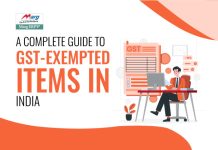Introduction
Goods and Services Tax (GST) is a comprehensive tax system that has been implemented in India since July 2017, replacing various indirect taxes like Value Added Tax (VAT), Central Excise, Service Tax, etc. It is a destination-based tax levied on the supply of goods and services across the country. In this blog, we will focus on understanding the nuances of GST billing in the state of Himachal Pradesh, including the applicable rates, invoicing requirements, and compliance procedures.
GST Rates in Himachal Pradesh
Himachal Pradesh, like other states in India, follows the GST rate structure that has been defined by the GST Council. The rates are categorized into four slabs: 5%, 12%, 18%, and 28%. However, some goods and services are exempted from GST, such as fresh fruits and vegetables, unprocessed food grains, education services, healthcare services, etc. It is important for businesses in Himachal Pradesh to understand the correct GST rates applicable to their products or services to ensure accurate billing.
GST Invoicing Requirements
Under the GST regime, businesses are required to follow specific invoicing requirements for their supplies of goods and services. In Himachal Pradesh, the following information must be included in a GST invoice:
- Name, address, and GSTIN (Goods and Services Tax Identification Number) of the supplier
- Name, address, and GSTIN of the recipient
- Invoice number and date
- Description, quantity, and value of goods or services supplied
- HSN (Harmonized System of Nomenclature) code for goods or SAC (Services Accounting Code) for services
- GST rate and amount of tax charged (CGST, SGST/UTGST, and IGST)
- Total invoice value
It is essential to ensure that invoices are issued in accordance with the GST rules to avoid any compliance issues or penalties.
Compliance Procedures
Compliance is a critical aspect of GST billing in Himachal Pradesh. Here are some key compliance procedures that businesses need to follow:
- GST Registration: Businesses with an annual turnover of Rs. 20 lakhs or more (Rs. 10 lakhs or more for specified states) are required to register under GST. Businesses engaged in interstate supplies or providing online services are also required to register, irrespective of their turnover.
- Filing of GST Returns: Registered businesses need to file regular GST returns, including GSTR-1 (outward supplies), GSTR-3B (summary return), and GSTR-2A (auto-populated inward supplies) by the due dates. Non-compliance in filing returns can attract penalties and interest.
- Input Tax Credit (ITC): Businesses can claim ITC on the taxes paid on their purchases, subject to certain conditions. It is crucial to reconcile the ITC as per the invoices uploaded by suppliers in GSTR-2A with the ITC claimed in GSTR-3B to avoid any mismatches.
- E-way Bill: For the movement of goods worth Rs. 50,000 or more, businesses are required to generate an e-way bill on the GST portal, including details such as the consignment value, transporter details, etc. This is applicable for both intrastate and interstate movements.
Key Challenges and Best Practices
While implementing GST billing in Himachal Pradesh, businesses may face some challenges such as understanding the correct GST rates for their products or services, complying with the invoicing requirements, reconciling ITC, and generating e-way bills. Here are some best practices to overcome these challenges:
- Stay Updated with GST Changes: GST is a dynamic tax system, and the rates, rules, and procedures are subject to change. It is crucial to stay updated with the latest notifications, circulars, and amendments issued by the GST authorities to ensure compliance with the current regulations.
- Maintain Accurate Records: Maintaining accurate records of all invoices, receipts, and other relevant documents is essential for smooth GST billing. It helps in reconciling ITC, filing accurate returns, and responding to any audits or inquiries from the tax authorities.
- Use GST-Compliant Accounting Software: Using GST-compliant accounting software can simplify the billing process and help in generating accurate invoices as per the GST requirements. It can also assist in reconciling ITC, generating e-way bills, and filing GST returns in a timely manner.
- Train Employees and Vendors: Providing adequate training to employees and vendors on GST regulations, invoicing requirements, and compliance procedures can ensure that they are aware of the correct procedures to be followed. This can help in avoiding any errors or discrepancies in GST billing.
- Seek Professional Help, if Required: GST can be complex, and businesses may require professional assistance to ensure compliance. Engaging with a qualified Chartered Accountant or GST consultant can provide expert guidance on GST billing, compliance, and help in resolving any issues or disputes with the tax authorities.
Conclusion
Implementing GST billing in Himachal Pradesh requires businesses to understand the applicable rates, invoicing requirements, and compliance procedures. It is crucial to stay updated with the changing GST regulations, maintain accurate records, and use GST-compliant accounting software. Training employees and vendors, and seeking professional help when required, can further ensure compliance and avoid any penalties or legal hassles. By following best practices and adhering to the GST rules, businesses can simplify their billing process and contribute to the smooth functioning of the GST regime in Himachal Pradesh.
Read more useful content:





